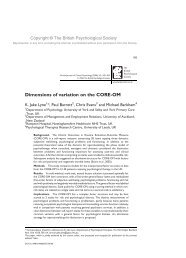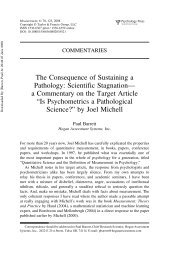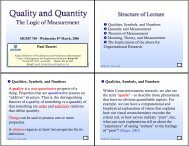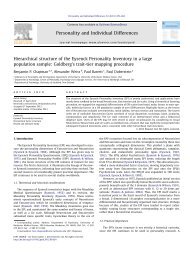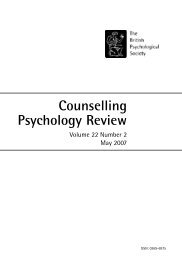Psychophysiological Methods - Paul Barrett
Psychophysiological Methods - Paul Barrett
Psychophysiological Methods - Paul Barrett
- No tags were found...
Create successful ePaper yourself
Turn your PDF publications into a flip-book with our unique Google optimized e-Paper software.
Breakwell-3389-Ch-08.qxd 2/7/2006 8:49 PM Page 155scalp, encompassing all electrode positions and the intervening spaces betweenelectrodes. In addition, chaos theory (non-linear dynamic analysis or fractaldimensionality analysis) has very recently been applied to the background EEGas a method for determining the ‘complexity’ of the EEG. For AEP research, measuresinvariably focus on peaks and troughs in the waveform, characterizingthese components by their amplitude and latency from the point of stimulation.Some work has also focused on the spectral composition of the AEP. Particularlypromising has been analysis that uses the wavelet transform, which allows amulti-resolution analysis of time-varying signals and which is especially suited tolocating the time interval within which a high-frequency signal, such as the brainstemauditory evoked potential, occurs (see Samar, Swartz & Raghuveer, 1995).Contemporary EEG work frequently uses high-density recording (seeOostenveld & Praamstra, 2001) where many electrodes are placed on the scalp,yielding a relatively high-resolution topographical map. Using this type ofrecording, Huber, Ghilardi, Massimini and Tononi (2004) have been able to showthat slow wave sleep may be crucial to learning new tasks. Specifically, theyfound that learning a new task may trigger an increase in slow wave sleep activityin the relevant brain area, which in turn may enhance task performance.However, despite advances in the topographic mapping of EEG data its spatialresolution is still relatively poor. Fortunately, complementary techniques formeasuring brain activity, such as functional magnetic resonance imaging (seeBox 8.1), have relatively good spatial resolution. When used together, these techniquesmake an especially particularly powerful combination to measuring thebrain activity associated with psychological processes.Box 8.1Functional magnetic resonance imagingFunctional magnetic resonance imaging (fMRI) is currently the fastest-growingmethod for relating brain activity to psychological processes and behaviour. Whilstthe hardware and facilities required are extremely expensive, they are becomingincreasingly available to researchers working in psychology departments, with anumber of departments having their own fMRI facilities.Functional magnetic resonance imaging works by detecting the radiofrequencyenergy emitted by the nuclei of atoms as they align with a strong magnetic field. Participantsin fMRI studies are placed inside a scanner, which fundamentally comprisesa large, high-strength magnet, various coils that make local adjustments to the staticmagnetic field generated by the large magnet, and radiofrequency transmitting andreceiving coils. The participants are stimulated in some way, for instance, by presentationof visual stimuli, whilst their brain activity is measured as described next.Essentially, a radiofrequency pulse is used to flip the nuclei out of alignment withthe magnetic field and then, as they move back into alignment, they emit radiofrequencyenergy – the magnetic resonance signal – that is measured by a receiver(Continued)PSYCHOPHYSIOLOGICAL METHODS155



